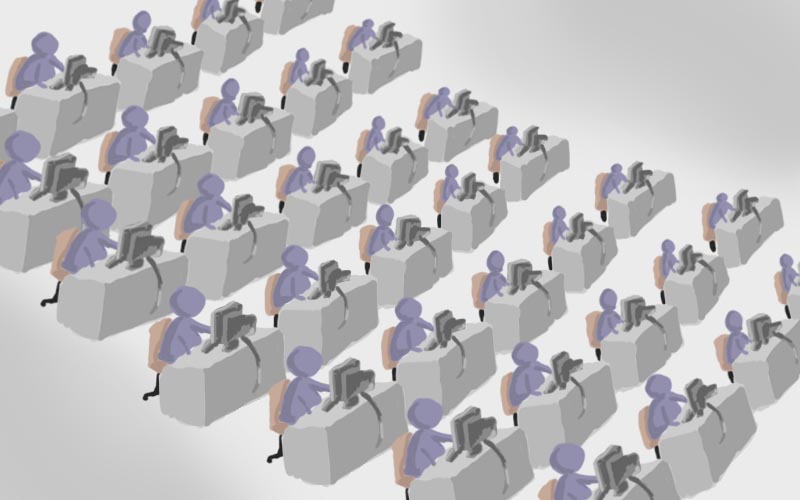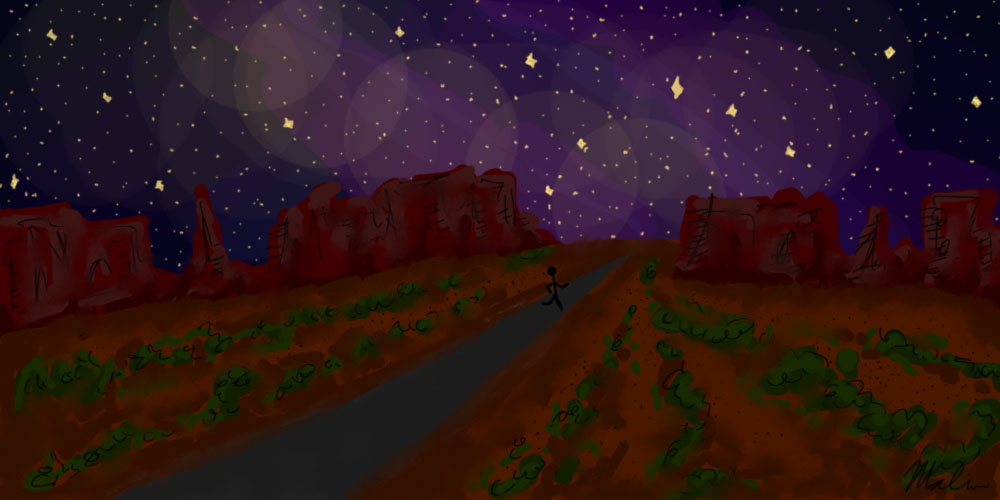When I tell people I run ultramarathons, a common response is: I don’t even like driving that far. Don’t you get bored running for so long? It’s so repetitive. Yes, well, yes, I say, it is repetitive, and sometimes it is boring. In a sense, it’s just one foot in front of the other a million times until you’re done. And then you do it again tomorrow. It doesn’t get much more repetitive than that. But all the same, I enjoy doing it. I just enjoy running. The conversation only goes downhill from there. Usually, we change to another topic. We’re unsettled because something seems amiss here: We think we shouldn’t enjoy things that are repetitive and boring.
I was recently on a faculty panel speaking to a class of first-year students about career paths. A young man with an edge of angst in his voice said, “Right now my life just feels like I’m working really hard for five days, then relaxing for two days, then doing it all over again, and again, and again. Some people say that it’s different when you graduate, that it’s less repetitive because you don’t have homework. But I don’t think it will be: You’re still working for five days, then you have the weekend, then you go back to work. It’s so repetitive. How do you break out of that?”
Like this student, we tend to think boredom and repetition are the enemies. As David Foster Wallace writes in The Pale King, a novel following the humdrum work lives of a handful of IRS employees: “Routine, repetition, tedium, monotony, ephemeracy, inconsequence, abstraction, disorder, boredom, angst, ennui — these are the true hero’s enemies, and make no mistake, they are fearsome indeed. For they are real.”

But is repetition really the enemy? “What would life be if there were no repetition?” asked Søren Kierkegaard. “Who could want to be a tablet on which time writes something new every instant, or to be a memorial volume of the past?” On the surface, we may like the idea of new, new, new. But think about it: What if you never could go back to the same home after work, and never work at the same place for more than a day? What if you had to find new friends every time you wanted to go for a beer? And that beer you loved — you can never have it again. Clearly, we need some measure of repetition in our lives. But what kind of repetition? And how much?
These were questions that occupied Kierkegaard in the early 1800s, just as they occupy us today. His entire philosophy, you could say, is centered upon repetition. It’s intriguing, then, that his book Repetition is not among his most well-known works. Perhaps this is because it took the form of a strange epistolary novel about a lascivious psychologist who seemingly tries to win a cold-footed young man from his fiancée. Or perhaps because it was published on the same day as two other Kierkegaard books — far predating the now-and-again musician’s strategy of dropping multiple albums on the same day.
Early in Repetition, Kierkegaard — or rather, his pseudonymous narrator, Constantin Constantius — presents a theory of repetition, and the rest of the book illustrates his ideas. To explain what repetition means, Kierkegaard introduces its sister concept, recollection. These two are almost the same, but they go in opposite directions: Recollection points backward in time, and repetition points forward. Recollection is about sitting there thinking about the past in order to understand it, to uncover whatever truths lie there. If you’re like me, you might ruminate on particular conversations, replaying them again and again, trying to figure out what went wrong. This is also what is happening in the dark patches of an ultramarathon when rumination and negative thoughts overtake you. As Zak Wieluns says in the documentary 100: Head/Heart/Feet, “One negative thought can really ruin your day.”
Repetition, on the other hand, is about actively moving forward, inventing the truth of the future. For example, an architect who designs a new building is doing repetition. The building an architect creates will be a fact of existence in the future, but at the moment of design, it doesn’t yet exist. Later on, an art historian might study the building, trying to uncover those truths through recollection. In short, recollection is about understanding, but repetition is about living. As Kierkegaard wrote in one of his journals, “It is perfectly true, as the philosophers say, that life must be understood backward. But they forget the other proposition, that it must be lived forwards.”

Some people object to Kierkegaard’s theory here: Repetition is not the right word for this, they say. How is designing a building anything like repetition? It’s a new building, and there’s only one of them.
In its everyday sense, repetition means doing something over again — saying the same thing or doing the same action. But, of course, it is never possible to do the exact same thing twice. For it to be the exact same thing, every condition of the action and its surroundings would have to be identical; it would have to happen with the same force, atmospheric pressure and temperature, with the same food in your stomach, the same distractions in your head — and, of course, at the same time. This is what Wittgenstein meant when he wrote, “To say of two things that they are identical is nonsense, and to say of one thing that it is identical with itself is to say nothing.” To say we’re doing the same thing is to abstract away the details. We have to settle not for same, but for similar. So there is always something different between any two actions, even repeated ones. And that space of difference is the space of invention, of possibility. That difference is where we live.
Designing a new building, one which never existed before, might not seem like repetition, and yet an architect performs a set of processes again and again. As Rosalind Krauss wrote in her famous essay “The Originality of the Avant-Garde,” originality “itself emerges from a ground of repetition and recurrence.” Thinking, making pencil marks, talking, tapping at the keyboard. Looking a little more broadly, the design process is cyclical: observe, ideate, build and test, and if the solution is not fully satisfactory (it never is on the first try), then the process is repeated. Across projects, the architect repeats this structure. And throughout their education, as with the acquisition of any skill, the architect must practice, practice, practice. We learn through doing — through repetition. And learning is far more than accumulating a deposit of facts; it is the creation and formation of self.
For Kierkegaard, repetition is the way a person creates themselves. If this sounds obscure, think about the truth captured in clichés such as, “You are what you repeatedly do,” and, “If you want to change your beliefs, first change your behavior.” To be sure, if we are alive, we can’t help but repeat ourselves. We eat and eat and eat, to give one example. The very essence of life, down to the cellular level, is replication.

But lurking always in the background is the reality that we can never exactly repeat anything. This paradox, for Kierkegaard, is the ironic crux of life: Repetition is necessary for living but in the end also impossible. And this contradiction is at the forefront when it comes to interesting or complex experiences, ones which we might actually want to repeat. But as Constantin Constantius discovers, you can’t go to Berlin for the first time twice. The Japanese have a saying, ichi-go ichi-e, which could be translated as “just this once.” It’s about the utter impossibility of repetition. You might talk about the same things with the same people, but it’s never the same conversation. You might do the same thing day in and day out, but with every moment the sun is in a different place, the wind is different. Everything that ever happens — it’s all once-in-a-lifetime.
So the repetition of life, the repetition of learning, of building up oneself, is not really about repeating the exact same actions again and again. Rather, repetition is about making a choice and sticking to it. As they say in the world of improv comedy, “Make a choice, and then make it the right choice.” To live fully, we must make choices and constantly reaffirm certain of those choices. The choices we repeat are the people we become. Should I commit to this relationship? Should I take this job in that city? Should I have kids?
And this is scary. Perhaps that’s what bothers us about repetition, that the substance of repetition is commitment, and that with any commitment comes risk. The specter of all the things you didn’t commit to. But in life, we must make choices and commit to those choices, even if we can never know for certain what will happen next — even if we might really have been better off having made a different choice.
Kierkegaard is famous for his idea of the leap of faith: when we make a decision, no matter the detail with which we assess it, we can never know with certainty what the outcome will be. Again the irony: Even as we’re constructing our future self, we can’t really know for certain who that future self will be. Philosopher L. A. Paul writes in her book Transformative Experience that in making life’s big choices all we can do is be open to discovering who we’ll be on the other side of that choice. Like Charles Darwin, who made a list of the pros and cons of marriage and in the end could only write Marry—Mary—Marry Q.E.D., we must simply “make a choice, and then make it the right choice.” As humans, we must take leaps of faith all the time.
But even knowing this doesn’t make choice any less uncomfortable. When the horn goes off at the start of an ultramarathon, there’s always that lurching feeling. Even though I decided to do this of my own free will, paid for registration and a hotel, trained hard for months and made all the elaborate and necessary plans, there’s always a certain anxiety. It is hard. It does get boring. It is intimidating. Part of me doesn’t really want to do it. But once you start, what can you do but keep moving forward? With each step, the athlete reaffirms their choice to run an ultramarathon, reaffirms their commitment to themselves and their family and friends, reaffirms their commitment to becoming a particular but ultimately unknowable kind of person, and reaffirms their commitment to life itself.
In ultrarunning, we talk about making “relentless forward progress,” which is also the title of a famed training handbook by Bryan Powell. And this is what relentless forward progress means: taking a leap of faith, and committing to life through repetition, even despite all the inevitable obstacles. It’s hard, and we don’t always succeed. But if you understand the true nature of repetition, if you can see what’s going on beneath the surface, then maybe there’s not really any such thing as failure. For “the key to modern life,” as Wallace writes in The Pale King, “is to find the other side of the rote, the picayune, the meaningless, the repetitive, the pointlessly complex. To be, in a word, unborable. If you are immune to boredom, there is literally nothing you cannot accomplish.” •




